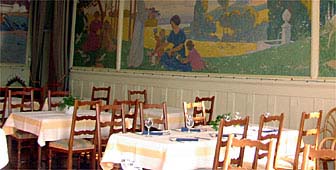Tradition of cures evolves in Chateau d’Oex

The Parc Hotel La Soldanelle in Chateau d'Oex is one of the last remnants of an era when the alpine village was regarded as a refuge for the sick.
Chateau d’Oex, the main alpine village in the Pays-d’Enhaut region north of Lake Geneva, is now better known for its annual hot-air balloon festival.
Recently, the Minotel group of hotels acquired the Soldanelle and has refurbished it, but the hotel has retained many of its original features, particularly the Belle Epoque façade and the Impressionist murals.
The refurbishing process, still in progress, is expected to include building a sauna in the hotel’s basement, where the chapel altars now stand.
A thousand metres up
The brief climb from the railway station to the hotel can leave a winter visitor knee-deep in snow.
The Soldanelle, which perches at the edge of a forest, was built in the early 1900s, and began life as the Hotel Alexandria. The founder, Dr Constantin Delachaux, set it up as a sanatorium staffed with physicians.
Many of the first patients were convalescing from lung diseases and tuberculosis; some were British veterans of the First World War.
The influx of English visitors to the village, particularly after the construction of the railway linking it to the ski resort of Gstaad and later, the Bernese Oberland, boosted Chateau d’Oex’s reputation as a place to regain one’s health and spirits.
The lion’s share of the Soldanelle’s clientele, as with the village itself, has tended to come from Britain. Many of the visitors stop at the Anglican church and the grave of actor David Niven.
“In this tourist village, we almost always had only English visitors,” said hotel manager Carol Bensada. “But now I feel there are fewer English visitors coming here because they are more hesitant to fly. We can feel it even if it is not a change of 100 per cent.”
Belgian priests
In the early 20th century, a group of Belgian priests bought it to use as a hospital for members of their order.
The only remnant of the priests’ ownership is the basement chapel.
The hotel’s Belgian link nonetheless continues.
Bensada says, “We have from time to time had Belgians who have visited here and told us about their memories of where they stayed or how they convalesced. Some of them are coming back after 30 or 40 years, and they can remember the place as it was once was.”
The tradition of rejuvenation continues at the Soldanelle in the form of a fitness and health training centre, supervised by a physician.
Many of the clients who use the facilities are often recovering from a major illness.
by MaryAnn Mathew

In compliance with the JTI standards
More: SWI swissinfo.ch certified by the Journalism Trust Initiative








You can find an overview of ongoing debates with our journalists here . Please join us!
If you want to start a conversation about a topic raised in this article or want to report factual errors, email us at english@swissinfo.ch.